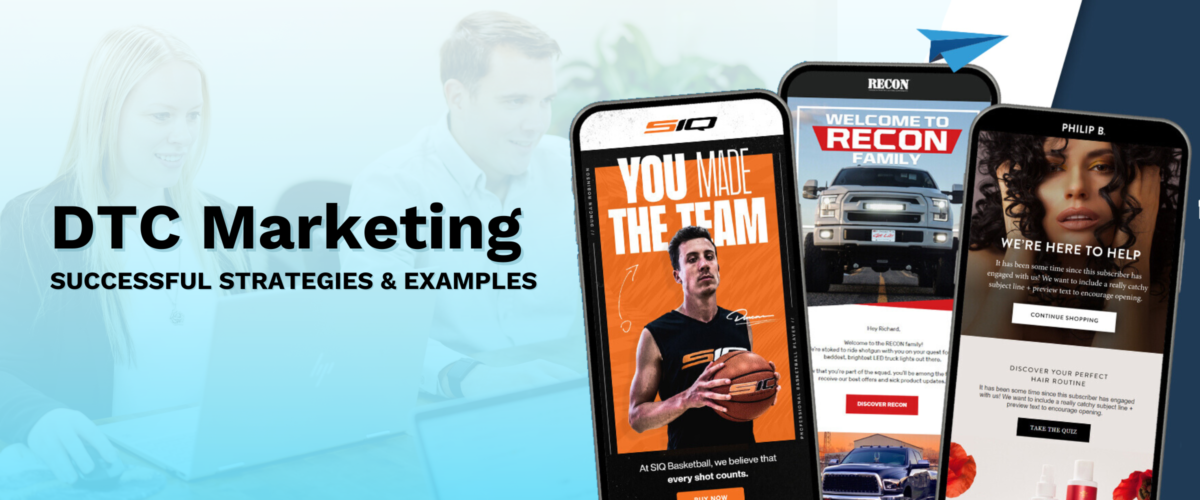Growing your business while keeping expenses low is a major goal of any commercial organization. However, to make this type of scaling efficient in terms of business development, you need to find practical marketing ways to expand your client base without going over budget. Direct-to-consumer marketing can give business owners perfect opportunities to do just that. This set of strategies has been popular among marketers for a while now and proven to be highly effective. Why? Let’s delve into the topic together. In this article, you’ll find a comprehensive analysis of the DTC marketing approach, its benefits and challenges, main channels with examples, as well as some valuable tips from Flowium’s experts.
What is DTC marketing?
First and foremost, let’s determine that DTC is an abbreviation of “direct-to-consumer”. If you ask “What does DTC mean in business?”, the answer will be that it is when companies sell their goods or services directly to consumers instead of going through middleman resellers. A simple example – instead of selling products to Walmart as a supplier for further distribution, you open your own brand store. That’s how you become a DTC brand.
Then another question may arise – “What does DTC mean in marketing?”. Giving a short definition, it is a set of marketing strategies employed by direct-to-consumer brands. The main DTC marketing meaning is aimed at the promotion of such brands without having to coordinate their marketing approach with mediators. For example, since “Puma” distributes their products on “Amazon”, the sportswear manufacturer company also depends on it to run its promotions. On the other side, DTC brands determine and execute their marketing programs and campaigns themselves by hiring a professional in-house team of marketers or a qualified marketing agency.
The takeaway is that since direct-to-consumer companies sell their products without resellers, they also have complete control over how those products and their brands are presented to the clientele. That is the general DTC meaning in marketing.
Pros and cons of DTC in marketing
Many seasoned businesses note the benefits that they receive by making their marketing strategy direct-to-consumer and often recommend startups employ this approach as well. Naturally, when there are advantages, there surely will be some impediments to the implementation of DTC in marketing. Let’s look into both sides of this coin and determine the major pros and cons that you should be aware of.

Benefits of direct-to-consumer
- Independence in branding. Realize your brand exactly how you envision it with the use of the DTC branding approach. It gives companies more control over their brand messaging, product representation, marketing, and distribution initiatives.
- More control over client engagement and relationships. Not only you can decide what your brand will look like but also what type of relationships you want to build with your client base. Apart from the quality of trustworthiness that all businesses try to achieve, you can establish multidimensional connections with customers, for example, offer self-services, create communities, or keep it transactional only. With DTC in marketing, you can consider various possibilities and their combinations to embody your ideal client relationships.
- Data-driven decisions. Instant client feedback on products or services, and marketing initiatives is possible with a DTC business strategy. Direct-to-consumer marketing gives you direct access to first-party data when you interact with your clients. This allows firms to rapidly test their strategies and gather feedback from consumers before making decisions on investments, entering new markets, management changes, re-branding, etc.
- Shorter time-to-market. Companies that rely on resellers and third-party retailers must appeal to all stakeholders if they want to initiate changes. That’s why they frequently hesitate to launch novel ideas. DTC brands don’t have such hindrances so they simply need to think about their customers and brand when experimenting with new products and its promotion strategies. As a result, manufacturers can make product improvements and get their products to market faster since they are not burdened by third-party channel coordination, seasonal delays, or other retail process disturbances.
Drawbacks of the DTC model in marketing
- Big investments. While large reseller and distribution organizations already have their marketing channels tuned, you’ll need a considerable initial investment, especially if you’re starting in a new market.
- Effort-consuming to gain contacts. Since there are no pre-built audiences, a substantial amount of time, money, and effort is required to launch promotion initiatives and increase brand recognition for your business.
- DTC brands are more liable. If your marketing strategy fails and it’s unable to attract enough clients or effectively market your goods, the whole weight of responsibility lies on your team.
Direct-to-consumer strategies
To gain maximum effect from your digital marketing effort, it’s important to not be fixated on one approach. Before making a purchase, 70% of shoppers check out at least three channels. Let’s take a look at the most popular marketing channels and analyze each direct-to-consumer strategy.
Email marketing
Professional email marketing services have helped many DTC campaigns experience an increase in the effectiveness of marketing activities. You can send tailored emails to particular email list segments and regular updates to the wider public. Essentially, this DTC marketing strategy is a must for every direct-to-consumer brand if they want to drive sales while gathering important first-party data from their audience. Based on the collected information, DTC marketers can determine their buyer persona, and make required data-driven changes in marketing strategies. Moreover, email marketing provides companies with efficient means to connect with customers based on their behavior by sending foundational emails e.g. welcome emails, abandoned cart emails, recommended products emails, etc. By dividing your audience into several groups, you can craft a message that is precisely customized to the needs and issues of each group. Because email marketing doesn’t rely on algorithms that restrict who may view the content you send, it is even more crucial for DTC digital marketing.
Many businesses recognize email marketing as one of the main DTC channels to engage with clients. Flowium has worked with many DTC e-commerce brands bringing them the desired increase in revenue and online sales of up to 50% via email marketing. You can make sure of the quality of our services by exploring the reviews from our esteemed clients.
Social media
Among DTC marketing strategies, social media marketing is a fantastic tool for communicating with clients and making sales. According to Statista, as of October 2023, 61.4% of the world’s population uses social media which makes this channel a golden mine for marketers and DTC businesses. That’s why this popular DTC channel has become a crucial component of any multichannel marketing plan, which is also considerably inexpensive. Social media marketing enables you to establish relationships with potential customers and raise brand awareness. By providing value and showcasing your brand’s personality on social media, you may build relationships with customers who will become devoted supporters of your business and its offerings and encourage them to make additional purchases.
One of the best DTC strategies on social media to remain at the top of your client’s mind is to post frequently. Even while you should have Instagram or Facebook accounts, don’t overlook the importance of marketing via TikTok, especially if your target audience includes younger people like millennials and Gen-Z.
Advertising
In addition to using organic direct-to-consumer marketing strategies, paid advertising can be highly advantageous for businesses as well. The purpose of direct-to-consumer advertising is to inform consumers about a product or remind them of their need for it through print, social media, TV, radio, and other media. To realize the full potential of your DTC advertising, look for ad opportunities based on the media your customers consume. You can find out what platform to use for ads by studying your target audience more closely and using data from other marketing channels to determine what kinds of content your potential client base likes. For instance, you should invest in social media ads using Facebook’s Ads Manager if your clients spend time scrolling through Instagram or Facebook.
Influencer marketing
Social media marketing and advertising are tightly connected with influencer marketing as one of the prominent direct-to-consumer strategies. Influencer marketing is the practice of a brand promoting one of its goods or services by working with an online influencer. Some DTC brands turn to influencers to help them become more recognizable. Overall, success in DTC marketing is greatly impacted by influencer marketing. It supports brands in increasing sales, content, and exposure.
SMS marketing
SMS marketing is a type of direct marketing where clients receive news, updates, and promotional offers via text messages on their phones. Its relative speed and favorable reception make it a simple and practical means of consumer communication. With 75% of consumers confirming they’re amenable to receiving messages from companies they are interested in, SMS marketing is becoming more and more popular. You’re losing out on a great chance to enhance buyer satisfaction and increase client retention if your direct-to-consumer organization isn’t using this DTC marketing channel yet.
Blogging
The core DTC marketing strategies of content marketing and blogging center on producing and sharing quality content that informs and engages your target audience. In your company’s blog, you can successfully turn attention to specific products, services, or offers by giving your readers and viewers detailed info, addressing popular questions and issues, etc. Maintaining consistency also contributes to the credibility of your brand as an information source. To keep your audience interested and returning for more, stick to a regular posting schedule. It is always better to favor well-researched and professionally designed content that connects with your audience and offers useful insights above quantity. In addition, search engine optimization (SEO) can play a crucial role in improving the visibility of your DTC brand by increasing organic traffic to your website.
Personalized offers
Effective direct-to-consumer marketing strategies include personalization and recommendation engines, which employ data-driven algorithms to tailor product recommendations for individual consumers. Businesses look at consumer behavior, tastes, and past exchanges to craft a personalized shopping experience. This tactic increases engagement and retention while simultaneously enhancing consumer satisfaction. By offering relevant and targeted product options via popular direct-to-consumer channels, brands may significantly boost sales and customer loyalty while also streamlining the purchasing process and strengthening the relationship.
Marketing tips for a better DTC experience
- Build and perfect your brand identity.
Companies that operate in the DTC marketing funnel must focus on creating a powerful brand image. Having an established and consistent brand identity is critical for making it recognizable and gaining the audience’s trust in your DTC product offers.
- Use diverse DTC marketing channels.
Remember the marketing rule of seven. It says a person needs to see your brand’s message about seven times before they decide to buy. This shows why it’s important to use lots of different ways to share information and ads. Putting all your effort into one method can cost a lot since there’s no guarantee it’ll work.
- Use the full potential of collected data.
It’s one of the best practices in direct consumer marketing for brands to try building better bonds with buyers by focusing on getting and analyzing top-quality user data. Since cookies are lessening, DTC companies need to develop strong ties with media providers and online advertising platforms to collect data from their marketing campaigns. A collected and thoroughly analyzed data can help you to form a clear vision about each consumer’s identity and measure the success of your direct-to-consumer marketing effort.
- Emphasize personalization.
Making each customer’s buying journey unique is important. Customers don’t want to be seen as just another data point. Personalization in your email marketing, SMS campaigns, targeted ads, etc. makes your audience feel more appreciated and involved which naturally leads to higher engagement and sales rates.
- Establish customer loyalty programs.
Show appreciation to your loyal clients in the form of perks and benefits. Focusing on boosting client loyalty is one of the proven methods of consumer direct marketing. Offer them gift cards, bonus points, and discounts for joining your community, social media, email subscriptions, published reviews or tags on their accounts, etc. This tactic will be beneficial for both parties – clients gain bonuses, and your DTC company gains more engagement. If a client is happy, they’re more inclined to stick with the brand and suggest it to others.
- Build a community for your direct-to-consumer brand.
A tactical plan for boosting engagement and sales includes creating a lively brand community. This is done by directly communicating on digital social platforms or setting up internet discussions where clients can talk about their experience with the product and ideally recommend it to others. Forming these interaction spaces like social media sites and online forums, not only fortifies the brand’s community but also increases client happiness.
- Involve user-generated content and micro-influencers
Since many buyers nowadays seem to be suspicious of openly advertised products, DTC marketing often relies on user-generated content on social media and online forums. Instead of trusting ads right away, 99% of the time people look through reviews and experiences of others before purchasing. Professional DTC marketer teams know how to use this fact to their advantage. Another key aspect of DTC’s strategy is influencer marketing. Even if you don’t have the resources to collaborate with the most famous creators, you can involve micro-influencers to review and advertise your brand offers in more local niches.
Successful direct-to-consumer marketing examples
Warby Parker – successful DTC email marketing
Warby Parker takes its rightful place as one of the successful direct-to-consumer marketing examples. With a straightforward mission to increase the affordability and accessibility of glasses through direct-to-consumer sales, Warby Parker challenged the industry’s leading brands in eyewear. But because of their original concept (for the eyeglass market) and smart direct-to-consumer marketing, they’ve now achieved the highly sought-after unicorn designation. E-commerce email marketing is crucial for a company like Warby Parker which operates mostly online. This is one of the great D2C marketing examples where a company professionally uses email to connect with clients. Just look at the well-designed product recommendation email campaign by Warby Parker.

Flowium is ready to assist your DTC company in gaining success through email marketing. Our team creates even more spectacular and engaging emails to keep your clients hooked on your brand and interested in your new offers. Contact us any time to start a productive collaboration right away.
Stanley 1913 – viral on TikTok

Although Stanley isn’t fully a direct-to-consumer brand, a considerable segment of the company’s revenue comes from their DTC e-commerce. I decided to include this brand in the list of prominent DTC marketing examples because of the recent event (or rather an accident) that allowed this company to go viral on social media and gain astonishing engagement rates.
Not so long ago, a TikTok user Danielle posted a video about an unfortunate accident when her car was caught on fire. What amazed her and the viewers was that a branded “Stanley” cup despite being in the burning car wasn’t just undamaged but even still had ice in it! The video blew up and now more than 75 million people have seen this unintentional and unpaid advertisement of Stanley’s products. What brings our attention to this case is the reaction of Stanley 1913. The company’s marketers were able to pull out all the benefits of this situation for their DTC marketing effort and promotion. Stanley’s president also made a TikTok and posted it on the company’s official page promising to help Danielle to replace her vehicle. Both videos are unprecedented in terms of engagement, gaining millions of likes, comments, and shares and even making it to the news. For sure, Stanley gained many new clients and a considerable return on investment from this whole ordeal.
This case is a great direct-to-consumer marketing example of how smart businesses can make social media and user-generated content work on their promotion and growth.
Funboy – DTC rocking SMS marketing

Funboy is a DTC company that designs luxury pool floats and other backyard essentials for summertime. Their marketing strategy incorporates various channels and methods but what makes this DTC brand stand out is their incredible SMS marketing. Overall, SMS campaigns have a 98% open rate on average. Compared to routes like email or display ads, SMS marketing is still relatively young. However, over 50% of consumers have already chosen to receive marketing SMS campaigns. Funboy has made the right decision to seize opportunities to connect with their clients through SMS and take full advantage of this channel for their DTC market. The company’s team puts in the best effort while working on foundational messages like this welcome SMS below. In general, Funboy’s SMS strategy is one of the well-thought marketing direct-to-consumer examples.
Conclusion
I hope this article fully explains the matter of direct-to-consumer marketing, its main strategies, benefits, and other characteristics. Now, you know that in general DTC brands have many tools, like email marketing services and text message marketing, to drive sales. By using time-tested practices and channels, DTC businesses can better tailor customer experiences, solve problems, build solid relationships, and stay on top of new trends. If you want to know more about the latest marketing trends that can help you advance your business, subscribe to our newsletter.







